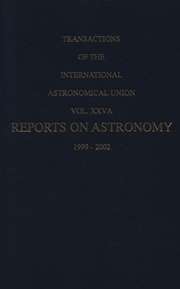No CrossRef data available.
Article contents
7. Celestial Mechanics
Published online by Cambridge University Press: 25 April 2016
Extract
The most exciting feature of contemporary celestial mechanics is the close interaction with three of the most dramatic engineering achievements of our time: the electronic computer, artificial celestial objects, and the precise measurement of distances in the solar system. The last two provide new information for and make new demands on celestial mechanics and the former provides an effective means of response. These developments have also stimulated people with backgrounds other than celestial mechanics to make contributions in the field.
Since the last meeting of the Union, the use of the computer for literal theoretical developments has become effective and widespread.
The creation of artificial celestial objects not only requires the services of celestial mechanics but provides the means of obtaining new measurements that may throw light on the physical laws that govern the motion of celestial objects. In other words, we can now perform experiments as well as observe.
- Type
- Research Article
- Information
- Copyright
- Copyright © Reidel 1970


